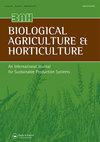Leguminous pre-crops improved quality of organic winter and spring cereals
IF 1.6
4区 农林科学
Q3 AGRONOMY
引用次数: 6
Abstract
ABSTRACT The aim of this research was to assess the effect of leguminous pre-crop species on quality characteristics of subsequent spring and winter cereals. The experiment was carried out in an organic crop rotation in north-eastern Europe. The influence of biomass dry matter yield, carbon and nitrogen content of perennial red clover (Trifolium pratense L.), alsike clover (Trifolium hybridum L.), Washington lupin (Lupinus polyphyllus Lindl.), biennial white sweet clover (Melilotus albus L.), annual crimson clover (Trifolium incarnatum L.) and Alexandria clover (Trifolium alexandrinum L.) on protein concentration, bulk density and thousand grain weight of subsequent cereals were assessed. Barley, oats, winter rye, spring and winter wheat were grown in the first post-legume year and barley and oats in the second post-legume year. In the first year after perennial and biennial pre-crops, the protein concentration of the cereals, except for rye, increased by 0.8–2.6 percentage points compared with the control. The largest increases in protein concentration of the cereals were after red and alsike clovers. The legumes increased the bulk density of all of the cereals, while thousand kernel weights were increased only for barley, spring and winter wheat. All the legume species had a positive second-year after-effect on the protein concentration of barley and oats, with the largest effect after red and alsike clover at 1.0–1.3 percentage points. The results showed that all of the leguminous pre-crops were suitable for increasing the quality of cereals. The effect was greater after perennial and biennial species compared with the annual species.豆科作物前茬提高了有机冬春谷物的品质
摘要本研究的目的是评估豆科作物对随后的春季和冬季谷物质量特征的影响。该试验是在欧洲东北部的有机作物轮作中进行的。多年生红三叶草(Trifolium pratense L.)、alsike三叶草(Trifolium hybridum L.)、Washington羽扇豆(Lupinus polyphyllus Lindl.)、二年生白三叶草(Melilotus albus L.)、一年生深红三叶草(Trefolium incarnatum L.)和亚历山大三叶草(Alexandria三叶草)的生物量干物质产量、碳氮含量对蛋白质浓度的影响,对后续谷物的容重和千粒重进行了评估。大麦、燕麦、冬黑麦、春小麦和冬小麦在后豆类第一年种植,大麦和燕麦在后豆类第二年种植。在多年生和两年期预作后的第一年,除黑麦外,谷物的蛋白质浓度比对照增加了0.8-2.6个百分点。谷物中蛋白质浓度增幅最大的是在红色和类似苜蓿之后。豆类增加了所有谷物的体积密度,而只有大麦、春小麦和冬小麦的千粒重量增加。第二年,所有豆类物种对大麦和燕麦的蛋白质浓度都有积极的影响,其中红三叶草和类似苜蓿的影响最大,为1.0-1.3个百分点。结果表明,所有的豆科前期作物都适合提高谷物的品质。与一年生物种相比,多年生和二年生物种的影响更大。
本文章由计算机程序翻译,如有差异,请以英文原文为准。
求助全文
约1分钟内获得全文
求助全文
来源期刊
CiteScore
3.30
自引率
6.70%
发文量
18
审稿时长
>36 weeks
期刊介绍:
Biological Agriculture & Horticulture aims to act as the central focus for a wide range of studies into alternative systems of husbandry, and particularly the biological or organic approach to food production. The Journal publishes work of a sound scientific or economic nature related to any aspect of biological husbandry in agriculture, horticulture and forestry in both temperate and tropical conditions, including energy and water utilization, and environmental impact.

 求助内容:
求助内容: 应助结果提醒方式:
应助结果提醒方式:


